Podcast: Play in new window | Download (Duration: 28:10 — 42.1MB)
Subscribe: Apple Podcasts | Spotify | Amazon Music | Android | Pandora | iHeartRadio | JioSaavn | Podcast Index | Email | TuneIn | RSS | More
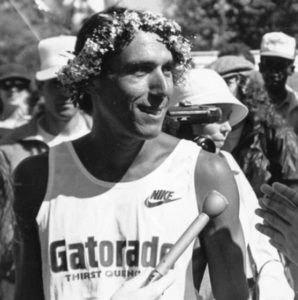 Stu Mittleman was the sixth person to be inducted into the American Ultrarunning Hall of Fame. During the 1980s, while a college professor from New York, he became the greatest multi-day runner in the country who won national championships running 100 miles, but ran much further than that in other races. During that period, no other American ultrarunner, male for female, exhibited national class excellence at such a wide range of ultra racing distances. He brought ultrarunning into the national spotlight as he appeared on national television shows and became the national spokesman for Gatorade.
Stu Mittleman was the sixth person to be inducted into the American Ultrarunning Hall of Fame. During the 1980s, while a college professor from New York, he became the greatest multi-day runner in the country who won national championships running 100 miles, but ran much further than that in other races. During that period, no other American ultrarunner, male for female, exhibited national class excellence at such a wide range of ultra racing distances. He brought ultrarunning into the national spotlight as he appeared on national television shows and became the national spokesman for Gatorade.
| Learn about the rich and long history of ultrarunning. There are now eleven books available in the Ultrarunning History series on Amazon, compiling podcast content and much more. Learn More. If you would like to order multiple books with a 30% discount, send me a message here.
|
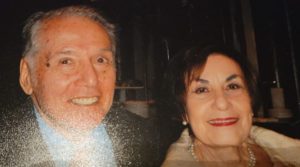

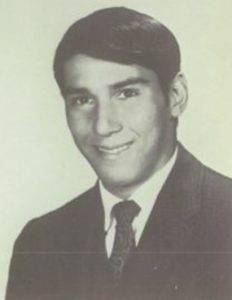

When he was in high school in Dumont, New Jersey in the late 1960s, he was on the track team and ran the mile in 4:39 mile, the half mile in 2:01. He was better at wrestling in which he lettered and was a district champion. At the University of Connecticut, he continued wrestling for one season but switched to long-distance swimming and weightlifting. At Colgate University, he was on the dean’s list and earned his bachelor’s degree in liberal arts. He earned his master’s degree at the University of Connecticut. He was a heavy smoker during school, going through two packs of cigarettes per day.
During the early ‘70s, he became disillusioned with the state of the country during the Vietnam War era and spent time on the West Coast, where he took up running again “for his head.” But while skiing in 1975, he had a terrible fall, tore his ACL and damaged cartilage. He had knee surgery and could not run for five months. When he could run again, he did it for relaxation and to find a quiet time for himself.
Becomes a Marathon Runner
In 1977, he ran up Flagstaff Mountain in Boulder, Colorado and fell in love with running. He went into a running store and asked how he could sign up for the Boston Marathon, three months away. They told him he needed to qualify, so he ran Mission Bay Marathon in San Diego with a qualifying time of 2:46. Early into his dream race at Boston, he was running in a drainage ditch in efforts to pass runners and twisted his ankle terribly. Disappointed, but determined, he tied ice around his swollen ankle and vowed not to drop out of the race. He finished in 4:03. He returned to Boston the next year and finished in 2:31:11. After finishing the New York City marathon six months later in 2:33:00, he couldn’t understand why he couldn’t run any faster, even though he was never tired at the end of his races. “I just started thinking, why did I have to stop? I wondered how much longer I could have run.” This thought made him turn to “the longer stuff.
First Ultramarathon
Mittleman was 5’ 8” and about 140 pounds. As a graduate student in sports psychology at Columbia University, Mittleman ran his first ultra in 1978, running 6:11 in the Metropolitan 50 in Central Park, New York. That year the race was poorly organized, and the front-runner went off course, but he placed 8th with 6:13. “I ended up sprinting the last 10 miles and I was hooked.” He liked ultras better than marathons because they were less competitive and they had a friendlier atmosphere.
The 1979 Unisphere 100
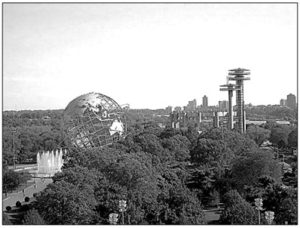

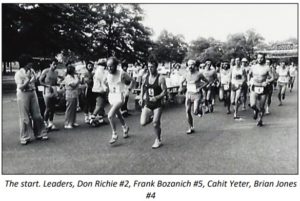

Mittleman said, “When I first considered 100 miles, I thought it was impossible. When I found out that people were doing it, it forced me to re-think that. The toughest decision was to go out and attempt it.”
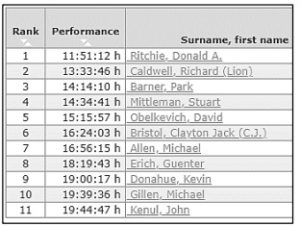

The 1980 New York Invitational 100 Mile Run
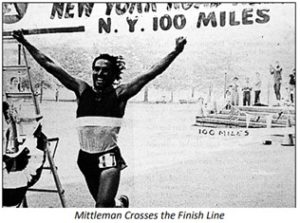

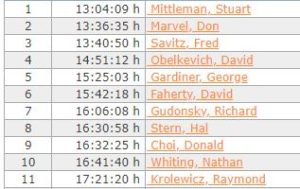

He told the New York Times, “I’m compulsive, obsessive. I seem to always have to try to do more and go farther. This 100-mile race is a good test of yourself. Everyone seems to be running the marathon. The ultramarathon is something different. Running gives a person a chance to explore themselves. Some really get heavily involved in it. For others, it’s like a form of relaxation and a chance to grow healthier.”
In the fall of 1980, Mittleman moved to Manhattan’s upper west side and could be seen running 120-200-mile weeks through Central Park, along Broadway, and along the avenues south to Battery Park. He said, “I like hopping over garbage cans and getting to know all the dogs in the neighborhood. It makes the whole experience less tense. If I run through Chinatown and Little Italy, I really feel like I’m taking a trip.”
The 1981 New York Invitational 100 Mile Run
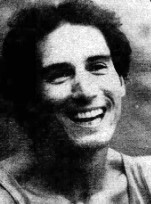

Mittleman was teaching history and sociology of sports in the health and physical education department of Queens College. He was also an adviser to a master’s degree program in athletic coaching at Columbia University, working on his doctorate in education in the field of sports psychology. He said, “Among the things I am working on is how emotions and personality effects an athlete’s physical ability. I can teach coaches to use that knowledge to train athletes.”
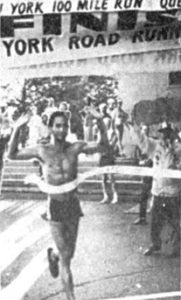

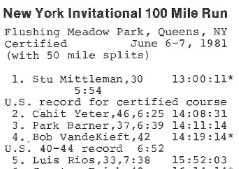

Mittleman refused to walk during 100-mile races. He said, “There’s no great secret to running 100 miles. I start out by treating it as a 100-kilometer race. When I get to 100 kilometers, which is 62 miles, I tell myself there are only 40 miles to go. You can’t practice running 100 miles to make the experience less awesome. There’s no way to water it down, so you go into it not knowing what to expect.”
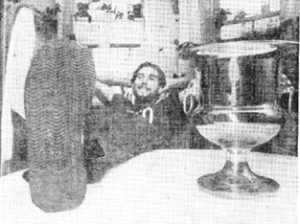

The 1982 New York Invitational 100 Mile Run
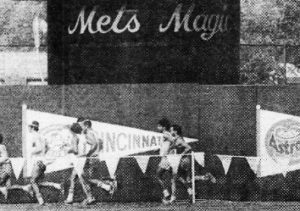

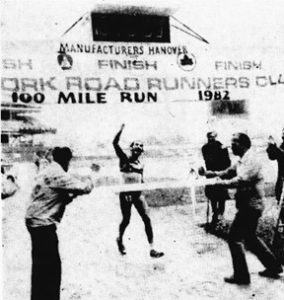

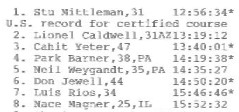



The race took its toll on Mittleman. For three hours after finishing, he could not stand up. “He needed two helpers to shuffle to a car. Speech slowed and slurred, he confessed, ‘I’m just devastated. Well, maybe I left the best part of myself out there today. I’ve never felt this way after a race. I guess it comes with the territory.” His win was awarded the Ultrarunning Performance of the Year by Ultrarunning Magazine. He received national attention and had a live interview on CBS after a boxing match. With that national exposure, he was hired to become the national spokesman for Gatorade.
The 1983 New York Invitational 100 Mile Run
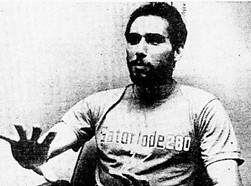

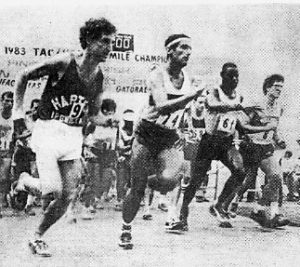

Mittleman Dominates in Shorter Ultras
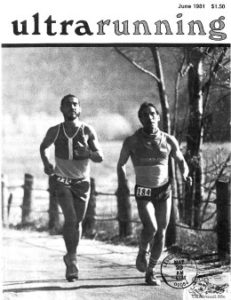

Mittleman used various shorter races to train for his 100-milers and multi-day races. At times, he would run and win races every other week. In 1981, he won the Lake Waramaug 50 Mile in 5:14:05, becoming #5 on the all-time U.S. list. In 1982 he ran a 6:57 at Lake Waramaug 100K, setting a course record that stood until 1994.


Mittleman used a unique approach when he would feel cramping starting during a race. “I try to visualize the muscles, the way they’re constructed and how they work. I focus my attention on the vision for some time and try to visualize the tension. Finally it does away.”
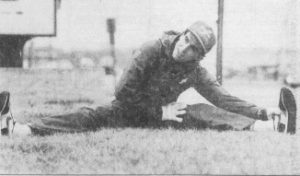

1983 New York Six-Day Race
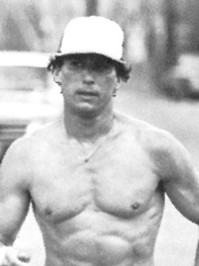

Mittleman, working on his PhD in sports psychology at Columbia University, was a rookie at multi-day races and first just went with a strategy to run as long as he could, rest and then run again. By 36 hours without sleep, he was a mess and only covered five miles in seven hours. He said, “I was hallucinating. The track temperature was 104 degrees and it was red clay. I felt like I was in a groove on a big muddy turntable (record player). I didn’t feel part of this planet.” A fellow ultrarunner told him to observe Sigfried Bauer, of New Zealand, who was using a strategy of running hard four hours, resting, and then repeating. Mittleman changed his strategy and things eventually came together. He said, “Toward the end, I found that it was more uncomfortable to rest in my tent than to be on the track with the other runners. The race became not a matter of individual will, but of community effort.” He went on to set a modern era six-day American Record of 488 miles, but came in short of Bauer’s winning distance of 511 miles. (The overall six-day American record was held by James Albert Cathcart, with 621.7 miles, set in 1888).
1984 New York Six-Day Race
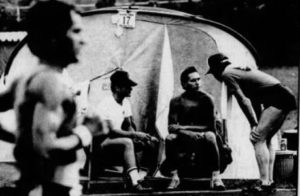

In a historic 1984 six-day race in New York City, Mittleman was the local favorite and got a lot of publicity. But he had what he considered a poor race with 502 miles, finishing 7th in a highly competitive race with 17 runners covering more than 400 miles. Yiannis Kouros of Greece, set a World Record and Mittleman had severe post-race depression with a foot problem. He wrote, “Searching for reasons, I could only conclude that my breakdown was the inevitable outcome of running as many miles as I did. I did not even for a moment, consider that my diet might have something to do with how I felt.” He met with Dr. Phil Maffetone who tried to convince him to get sugar out of his diet, eat more oils, and dramatically increase his consumption of water. Mittleman took the advice and a month later was back competing well. The theory was, “you need to eat fat in order to burn fat.”
Six-Day Race in France
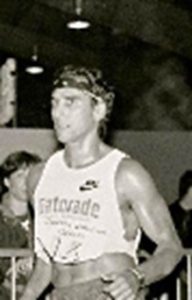

Two months later he was recovered and headed for La Rochelle, France, to run a 6-day race on an indoor 200-meter paved track inside an exposition hall. In the middle of the track was a restaurant and all sorts of entertainment. One runner said, “It is as if we are on show all the time.” Thousands of people showed up for the opening ceremonies. Twenty runners had been invited to compete, and in the days leading up the race, they made visits to schools and businesses. Mittleman decided to incorporate a new strategy for his six-day race. He would walk the first hour, run the next five, and repeat. He said, “The event begins, and the runners are off. The crowd roars and the music blares thunderously on. What do I do? I start walking. The crowd begins to yell, but not in support. I manage to hear taunts of ‘Yankee, go home.’ Mixed in with the more universal and easy to understand ‘boo.’” By the end of the first hour, he was in dead last, but when he ran, he would catch up, and then fall behind again as he walked. After two days, he was in the bottom third of the field. But on day three, he was able to run faster than anyone else. By the end of day four, he was closing in on the leaders. He moved into second place, but was too far behind to win. He finished in second place with 571 miles, setting a new modern-era American Record (50 miles behind the all-time American record set in 1888). After the race, a spectator that came every day came up to him and said, “I have never seen a race like that before, Bravo Mittleman.”
More Six-Day Races
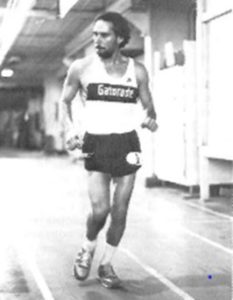

Mittleman had his sights on breaking 600 miles during six days, an accomplishment that only three Americans in history had achieved, doing it nearly 100 years earlier. He felt that he could do it at the 1984 Rocky Mountain 6-day race run at altitude in Boulder, Colorado. It was held in the University of Colorado Fieldhouse on a tiny 220 yard track. It was observed that every minute of every day of Mittleman’s run was planned and accounted for, including every meal. He ran an amazing 215 miles during the first two days, determined to break 600 miles. But on day five, he developed Achilles tendon problems because of shoes that were too small, and had to walk the rest of the way. He did extend his personal best to 577 miles. This had been Mittleman’s third six-day race in six months and he exceeded 500 miles in all of them. He commented, “We’re still learning about 6-day racing.” (In 1899, George Noremac, also of New York City, concluded his six-day racing career with 16 six-day races with more than 500 miles, the most 500+ finishes in history.)
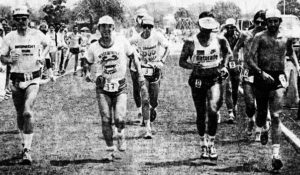

In early 1985, Mittleman ran in the New Astley Belt race held at El Cajon, San Diego, California. He ran 124 miles on the first day, but the heat slowed him down and after four days, he was not being pushed by any competition and ended up with 534 miles to win that race by 111 miles. One onlooker commented about the heat’s effects on the runners, “Their lips looked like their feet.” In June 1985, he ran in the sixth-annual Edward Payson Weston Six Day Track Race held in New Jersey. He unexpectedly dropped out while leading with 191 miles on the second day.
The 1986 1,000-mile race
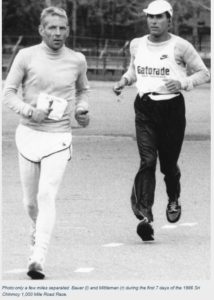

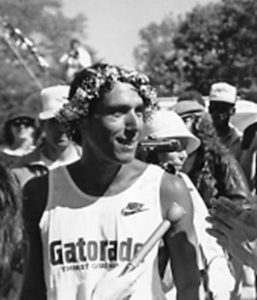

In 1988, Mittleman ran a 12-hour run in Syosset, New York, on a track, and came in third with 73 miles. He also ran the 100 mile race at Shea Stadium that year, but dropped very early, at mile 16. Soon thereafter, he put a hold on his competitive running career at the young age of 37 to devote his time developing his fitness training business, “WorldUltrafit” that he founded in 1987.
Coming out of Retirement
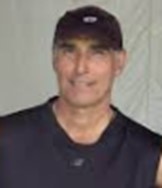

Slow Burn
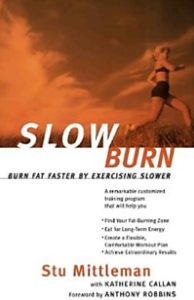

Sources:
- Stu Mittleman, Slow Burn
- The Record (Hackensack, New Jersey), Dec 9, 1967, Sep 21, 1972, Jun 21, 1973, Jun 17, 1979
- Newsday (Melville, New York), Apr 18, 1978
- Nick Marshall, Ultra Distance Summary, 1979, 1980
- Ultrarunning Magazine, Jul 1981, Jul 1982, 1983, 1984, Jul 1986
- Daily News (New York, New York), Jun 14, 1981, Jun 14, 16. 18, 1983
- The Central New Jersey Home News (New Brunswick, New Jersey), Jun 8, 1981
- The Courier-News (Bridgewater, New Jersey), Jun 8, 1981, Jun 7, 1982, Mar 14, 1983
- The Record (Hackensack, New Jersey), Aug 31, 1981
- Hartford Courant (Connecticut), May 9, 1981
- Press and Sun Bulletin (Binghamton, New York), Jun 9, 1983
- The Buffalo News (New York), Jun 10, 1984
- Hartford Courant (Connecticut), Jun 1, 1984
- The Record (Hackensack, New Jersey), Jul 25, 1984


